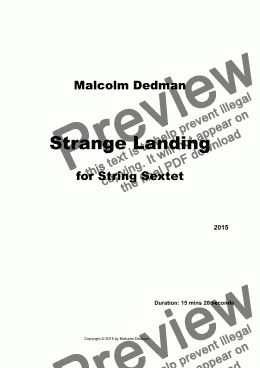Ready to print
You have already purchased this music, but not yet printed it.
This page is just a preview and does not allow printing. To print your purchase, go to the My purchases page in your account and click the relevant print icon.

Already purchased!
You have already purchased this score. To download and print the PDF file of this score, click the 'Print' button above the score. The purchases page in your account also shows your items available to print.
This score is free!
Buy this score and parts
Strange Landing
$1.50
$0.50
from $0
Preview individual parts:
Instant download
You are purchasing high quality sheet music PDF files suitable for printing or viewing on digital devices.Strange Landing was written in 2015 and is for String Sextet – 2 each of violins, violas and cellos. The duration is 15.5 minutes.
The title implies a landing in some new environment, perhaps on a new planet with no chance of escape, or even a dream. The work is in three movements: Familiar, yet Unfamiliar; Stranger than Fiction and Progressing to Acceptance.
The first movement starts with aggressive chords that give way to a calmer allegro section (the ‘familiar’). After a return to the opening chords, the movement continues with a new section, containing short melodic phrases (the ‘unfamiliar’). These phases are expanded in the next section over a rocking accompaniment, interrupted by another variant played pizzicato. The opening chords return, followed by a return to the calm allegro which closes the movement.
The second movement is a kind of scherzo and divides the sextet into two trios, each containing a violin, viola and cello. The two trios are in direct conflict with one another. The first trio creates a mysterious atmosphere and the second trio contrasts this with pizzicato phrases, the three instruments appearing in conflict with one another. When later both trios play these simultaneously, chaos abounds! The central section builds up a texture in the first trio, then the second joins in – in a different key – and definitely still in conflict with the first. The remainder of this movement is an unresolved conflict between the two trios.
The third movement is mainly adagio and is a lot more calm, but opening with mysterious chords in 5/4 time. This is resolved by a contrapuntal section which suggests a pentatonic scale. A triple meter section soon follows which develops the chords and melodic phrases already stated. The mysterious chords return, but this time resolves to a less strange harmony, implying acceptance. The triple meter section returns, varied, followed by the contrapuntal section that ends the piece calmly.



